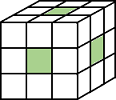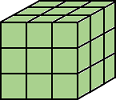bwulterode
Ultimate erosion
Description
Examples
Read a binary image into the workspace and display it.
originalBW = imread('circles.png');
imshow(originalBW)
Perform the ultimate erosion of the image and display it.
ultimateErosion = bwulterode(originalBW); figure, imshow(ultimateErosion)

Input Arguments
Binary image, specified as a numeric or logical array of any dimension. For numeric input,
any nonzero pixels are considered to be 1 (true).
Example: BW = imread('circles.png');
Data Types: single | double | int8 | int16 | int32 | int64 | uint8 | uint16 | uint32 | uint64 | logical
Distance transform method, specified as one of the values in this table.
Method | Description |
|---|---|
"chessboard" | In 2-D, the chessboard distance between (x1,y1) and (x2,y2) is
max(│x1 – x2│,│y1 – y2│).
|
"cityblock" | In 2-D, the cityblock distance between (x1,y1) and (x2,y2) is
│x1 – x2│ + │y1 – y2│
|
"euclidean" | In 2-D, the Euclidean distance between (x1,y1) and (x2,y2) is
|
"quasi-euclidean" | In 2-D, the quasi-Euclidean distance between (x1,y1) and (x2,y2) is
|
For more information, see Distance Transform of a Binary Image.
Pixel connectivity, specified as one of the values in this table. The default
connectivity is 8 for 2-D images, and 26 for 3-D
images.
Value | Meaning | |
|---|---|---|
Two-Dimensional Connectivities | ||
| Pixels are connected if their edges touch. The neighborhood of a pixel are the adjacent pixels in the horizontal or vertical direction. |
Current pixel is shown in gray. |
| Pixels are connected if their edges or corners touch. The neighborhood of a pixel are the adjacent pixels in the horizontal, vertical, or diagonal direction. |
Current pixel is shown in gray. |
Three-Dimensional Connectivities | ||
| Pixels are connected if their faces touch. The neighborhood of a pixel are the adjacent pixels in:
|
Current pixel is shown in gray. |
| Pixels are connected if their faces or edges touch. The neighborhood of a pixel are the adjacent pixels in:
|
Current pixel is center of cube. |
| Pixels are connected if their faces, edges, or corners touch. The neighborhood of a pixel are the adjacent pixels in:
|
Current pixel is center of cube. |
For higher dimensions, bwulterode uses the default value
conndef(ndims(BW),'maximal')
Connectivity can also be
defined in a more general way for any dimension by specifying a 3-by-3-by- ... -by-3 matrix of
0s and 1s. The 1-valued elements
define neighborhood locations relative to the center element of conn. Note
that conn must be symmetric about its center element. See Specifying Custom Connectivities for more information.
Data Types: double | logical
Output Arguments
Eroded image, returned as a logical array of the same size as
BW.
Data Types: logical
Version History
Introduced before R2006a
MATLAB Command
You clicked a link that corresponds to this MATLAB command:
Run the command by entering it in the MATLAB Command Window. Web browsers do not support MATLAB commands.
选择网站
选择网站以获取翻译的可用内容,以及查看当地活动和优惠。根据您的位置,我们建议您选择:。
您也可以从以下列表中选择网站:
如何获得最佳网站性能
选择中国网站(中文或英文)以获得最佳网站性能。其他 MathWorks 国家/地区网站并未针对您所在位置的访问进行优化。
美洲
- América Latina (Español)
- Canada (English)
- United States (English)
欧洲
- Belgium (English)
- Denmark (English)
- Deutschland (Deutsch)
- España (Español)
- Finland (English)
- France (Français)
- Ireland (English)
- Italia (Italiano)
- Luxembourg (English)
- Netherlands (English)
- Norway (English)
- Österreich (Deutsch)
- Portugal (English)
- Sweden (English)
- Switzerland
- United Kingdom (English)




